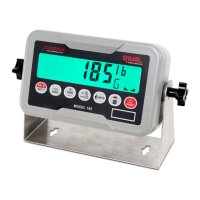8400-0181-OM Rev C 185 and 185B Installation & Technical
3
SITE PREPARATION REQUIREMENTS
The Model 185 and 185B Weight Indicators are precision weight indicating instruments. As
with any precision instrument, it requires an acceptable environment to operate at peak
performance and reliability. This section is provided to assist you in obtaining such an
environment.
Environmental
The Model 185 and 185B Weight
Indicators meet or exceed all certification
requirements within a temperature range of
14 to 104 °F (-10 to +40 °C).
In order to keep cooling requirements to a
minimum, the indicator should be placed
out of direct sunlight, and the area around
the indicator kept clear to provide adequate
air circulation.
Do not place the indicator directly in front
of a heating or cooling vent. Such a
location will subject the indicator to sudden
temperature changes, which may result in
unstable weight readings.
Make sure the indicator has good, clean
AC power, and is properly grounded. In
areas subject to lightning strikes, additional
protection to minimize lightning damage,
such as surge suppressors, should be
installed.
Electrical Power
The Model 185 and 185B Weight Indicator
have been designed to operate from a 100
to 240 VAC 50/60Hz 12 VDC 1 A wall plug-
in UL/CSA listed AC power adapter
(Cardinal part number 8400-0182-0A).
The socket-outlet supplying power to the indicator should be on a separate circuit from the
distribution panel and dedicated to the exclusive use of the indicator.
The socket-outlet shall be installed near the equipment and shall be easily accessible.
The wiring should conform to national and local electrical codes and ordinances, and
should be approved by the local inspector to assure compliance.
On installations requiring 230 VAC power, it is the responsibility of the customer to have
a qualified electrician install the proper power adapter plug that conforms to national
electrical codes and local codes and ordinances.

